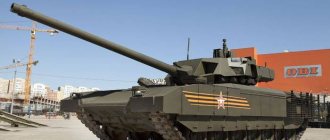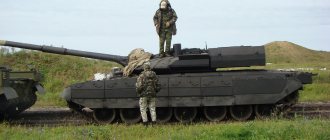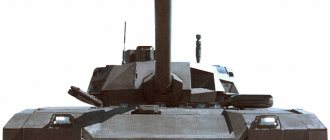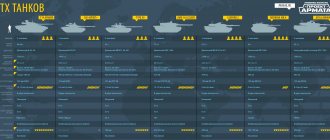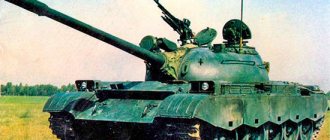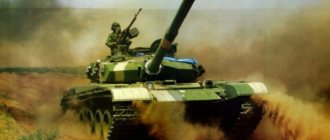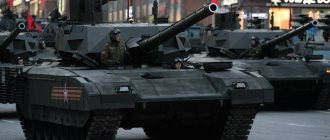In 2015, at a military parade in Moscow dedicated to the 70th anniversary of Victory in the Great Patriotic War, the latest Russian development was presented to the general public - the T-14 Armata tank, which should radically affect the equipment of the Russian ground armies and determine the concept of their applications for the coming decades. This tank, positioned as a 4th generation tank, has aroused great interest both in our country and throughout the world. In this article we will look at the history and background of the creation of the Armata tank, its distinctive features and technical characteristics, as well as prospects for use in real combat operations.
Basic information about the T-14 “Armata” tank
The T-14 tank is the latest Russian tank of the 4th generation on the Armata universal heavy combat tracked platform. The tank received the “14” index, as usual, according to the year the project was implemented – 2014. At the project stage, the tank had the designation “Object 148”.
It is believed that the T-14 Armata tank is the world’s first 4th generation tank, the first tank within the framework of the concept of network-centric warfare, and that it has no analogues at all. In general, according to many of our and foreign experts, today the Armata is the best tank in the world.
First, let's take a quick look at what this new Armata tank is, what design solutions our design engineers implemented in it, and what main features it has:
Main features of the T-14 “Armata” tank
- The tank has an uninhabited turret. It is equipped with a proven remote-controlled 125 mm smoothbore gun with an automatic loader.
- The design of the tank allows it to be equipped with a 152 mm gun, already tested on the Object 195.
- The tank's crew is housed in an isolated armored capsule that can withstand direct hits from all existing modern anti-tank shells.
- The armored capsule with the crew is securely separated from the ammunition and fuel tanks.
- The active suspension will allow the tank to conduct accurate aimed fire at speeds of up to 40-50 km/h.
- It is assumed that the active suspension will allow the tank to move at speeds of up to 90 km/h not only on the highway, but also over rough terrain.
- The new type of combined multilayer armor used in the tank is 15% different than that used in domestic 3rd generation tanks. The equivalent thickness of the armor is about 1000 mm.
- All tank modules are controlled by the latest tank information and control system (TIUS), which, if any malfunction is detected, notifies the crew about it with an appropriate voice message.
- The Armata radar complex uses active phased array radars capable of tracking about 40 ground and 25 air targets at a distance of up to 100 km.
- If the Afghanit active protection complex detects a projectile flying at a tank, it automatically turns the tank’s turret towards this projectile in order to meet it with more powerful frontal armor and be ready to deliver a counter-attack to the enemy who fired this projectile.
- The destruction range of a 125 mm gun is up to 7000 m, while for the best Western models this parameter is 5000 m.
- The Armata tank uses a large number of effective stealth technologies that make it practically invisible or difficult to detect for many types of weapons.
Performance characteristics of the T-14 “Armata” tank
!!! To view the table on mobile devices, move it left and right.
| Tactical and technical characteristics of the T-14 “Armata” tank | |
| Crew | 3 persons |
| Weight | 48 tons |
| Main weapon | 125 mm 2A82-1M |
| Ammunition | 45 shells |
| Automatic loader | 32 shells |
| Rate of fire | 12 shots/min |
| Machine guns | 12.7 mm “Kord” and 7.62 mm PKTM |
| Target detection range | about 5000 m |
| Target range | about 7000 m |
| Engine | 12 cylinder diesel |
| Engine power | 1200-1800 hp |
| Power density | 31 hp/t |
| Suspension type | Active |
| Maximum speed | 90 km/h |
| Cross Country Speed | 40-60 km/h |
| Power reserve | 500 km |
| Armor | Combined multilayer |
| Armor thickness equivalent | about 1000 mm |
| Active protection | "Afghanite" |
| Dynamic protection | "Malachite" |
| Length (with gun) | 10.8 m |
| Width (with screens) | 3.9 m |
| Height | 3.3 m |
Infographics and arrangement of modules in the T-14 tank
A good infographic of the T-14 tank with the location of the modules was made by the RIA Novosti agency:
Video review “T-14 multi-purpose tank on the Armata tracked platform”
For the 80th anniversary of Uralvagonzavod, an interesting mini-video review about the T-14 Armata tank was released:
Well, now let’s talk about the T-14 “Armata” tank in more detail and discuss the history and background of its creation, its weapons and armor, the characteristics of its main systems, as well as the possibility of use in real combat operations.
Active protection complex "Afganit"
The Afghanit active protection complex (APS) is designed to protect tanks built on the Armata platform from enemy shells and missiles that are intended to destroy or damage a combat vehicle. This system is equipped with special charges designed to directly destroy enemy shells and missiles. This system is an analogue of individual missile defense, protecting the tank from most types of standard attacks.
Active protection completely covers the front hemisphere and the entire perimeter of the tank turret. It is located at different levels, which helps ensure a better system response in case of danger.
Currently, new active protection systems are being developed, which in the future are planned to be installed on combat vehicles of the Armata platform. The new systems will have such a fast response that they can intercept even high-speed kinetic missiles at a distance of at least 4 meters from the tank. It follows from this that not a single shell or missile that flies into the radius of action of the tank’s protective complex can harm it.
History and background for the creation of the new Armata tank
Another way
At the turn of the 2000s, Russia was developing 2 projects of a promising main battle tank, which should have become a replacement for the current Russian MBT - the T-90. One of them - “Object 460” or “Black Eagle” (see photo above) - was developed by the Omsk Design Bureau. It had an extended modified chassis from the T-80U tank, in which another one was added to the six rollers, as well as a narrowed turret of a new design, armed with the already proven standard 125 mm smoothbore gun. It was assumed that the mass of the tank would be about 48 tons, and it would be equipped with a 1500-horsepower gas turbine engine, which would give it a specific power of more than 30 hp/t and make it one of the most dynamic tanks in the world.
The second project - “Object 195” or “T-95” (see photo below) - was the development of the Ural Design Bureau and the Uralvagonzavod corporation. It was an “ubertank” for its time, which also featured an uninhabited (unmanned) turret armed with a formidable 152 mm smoothbore gun on a seven-wheel chassis. The tank's crew (only 2 people) was housed in an isolated armored capsule in the front of the hull. The weight of the tank was not small - about 55 tons, and it was supposed to be equipped with a 1650 hp diesel engine, which would also give it good dynamic characteristics.
It was assumed that the kinetic energy of the projectile fired from the 152 mm smoothbore gun of the Object 195 was so great that if it hit the turret of an enemy tank, it would simply tear it off.
But in 2009-2010, both projects had to be curtailed for several reasons. Firstly, the development of both tanks was not very active and during the design and testing period (which is about 15-20 years) they simply became obsolete. Secondly, the transition to the use of such supertanks as the T-95 - quite expensive and resource-intensive to produce - would, to some extent, be a transition to the German path of development of tank construction during the Second World War, i.e. the “path of the royal tigers and mice” that absolutely did not justify itself. We needed a universal, mass-produced tank, with the best price-quality ratio, like our famous T-34. And thirdly, both of these tanks did not quite correspond to the concept of network-centric warfare.
Network-centric warfare concept
Network-centric warfare is a modern military doctrine aimed at increasing the combat effectiveness of various military formations participating in armed conflicts or modern wars by combining all combat and support units into a single information network and, as a result, achieving infocommunication superiority over the enemy.
Those. it turns out that by combining and almost instantaneously communicating command and control means, reconnaissance means, as well as means of destruction and suppression, more accelerated control of forces and means is achieved, increasing the effectiveness of defeating enemy forces and the survivability of one’s own troops, and each participant in combat operations receives full and timely information about the real combat situation.
Tank formations must also be adapted to the modern realities of network-centric warfare; for this, the tanks themselves must be able to connect to a unified information network and be able to almost instantly transmit to it information received by the tank from the outside through their own “survey” modules. In fact, this is practically one of the requirements for the new 4th generation tanks.
4th generation tank
“Object 195” as imagined by the artist.
The classification of tanks by generation is actually not official, it is very arbitrary and looks something like this:
- The first generation includes tanks from the 1950s-1960s, such as the Soviet T-44 and T-54, the German Panther, the English Centurion and the American Pershing.
- The second generation is associated with the advent of the so-called main battle tanks (MBT). It includes tanks from 1960-1980, such as the Soviet T-62, American M-60, English Chieftain, German Leopard and French AMX-30.
- The third generation includes the latest modern tanks, such as the Soviet T-80 and Russian T-90, the American Abrams, the French Leclerc, the English Challenger, the Ukrainian Oplot, the South Korean Black Panther, and the Israeli Merkava. , Italian “Ariete” and German “Leopard-2” (By the way, you can read more about third-generation tanks in our article “Rating of modern tanks”).
It is clear that later generations of tanks were distinguished by more durable armor, more advanced protection and more formidable weapons. This also applies to the 4th generation of tanks, the appearance of which is long overdue. But besides this, as mentioned above, 4th generation tanks should be maximally adapted to network-centric warfare, and also, if possible, meet a number of other requirements:
- have an uninhabited turret and an automatic loader
- the crew must be isolated in an armored capsule
- the tank must be partially robotic
By the way, a fully robotic unmanned tank can be considered a 5th generation tank.
Our designers approached the development of a new tank with approximately the same list of requirements when, in 2010, after the winding down of the Object 195 and Object 640 projects, they received the task of designing a new generation tank as quickly as possible.
Platform “Armata”
The order for the design, testing and production of the new tank was received by the state corporation UralVagonZavod, located in Nizhny Tagil and engaged in the development and production of various military equipment. When developing a new tank, the Ural Design Bureau, affiliated with UralVagonZavod, actively used ready-made advanced developments for the “Object 195” that was already being developed here, as well as for the project of the Omsk Design Bureau - “Object 640”. Both closed projects greatly helped our designers to quickly cope with the task.
But the most important thing is that this time our designers (as well as our military leadership) saw the problem of building a new tank more broadly, and it was decided to develop not just a 4th generation tank, but a universal tracked platform that could be used to design a wide variety of military equipment, which would solve the above-described problem of universality, mass availability and price-quality ratio.
Thus, Uralvagonzavod designed and implemented the so-called unified combat heavy tracked platform "Armata", but on the basis of which it is planned to create about 30 different types of military equipment. Moreover, they will have in common not only a platform, but also a common battle control system, a common communication system, a common active protection system and many other components and modules.
The Armata universal heavy combat platform has three engine layout options: front, rear and middle. This allows the platform to be used for the design of almost any type of military equipment. For a tank, for example, they use a rear-mounted engine, but for an infantry fighting vehicle, on the contrary, a front-mounted one.
At the moment, our defense industry has already received the first units of equipment based on the new platform - this is the armored repair and recovery vehicle BREM T-16 (for now only as a project), the infantry fighting vehicle BMP T-15 and, of course, the main battle tank T-14.” Armata”, which we could already see at the Victory Parade in Moscow.
Waiting for "Armata"
While serial deliveries of the promising Armata have not begun, the troops are being replenished with three modern types of tanks. Before Defender of the Fatherland Day, the Ministry of Defense announced that in 2022 it would receive more than 170 modernized and new vehicles. Among them were more than ninety T-72B3 and T-72B3M, about eighty gas turbine T-80BVM. The first batch of T-90M “Proryv” was also mentioned.
According to the Ministry of Defense, T-90Ms will enter the Kazan Higher Tank Command School this year to train future officers.
Some of these vehicles will be produced from scratch, the rest will be modernized from the T-90A available to the troops. The updated version has a completely different, better protected turret, a modern gun and a fire control system (FCS).
Such guns and fire control systems allow the T-90M to use projectiles with remote detonation along the trajectory. They are especially effective when firing at infantry in cover. One of the externally subtle changes was the equipping of the tank with new control and communication systems. Now combat vehicles can be connected to a secure “military Internet” and connected with each other and with headquarters.
The most numerous of the updated tanks in the army was the T-72B3. When modernizing combat vehicles, they are equipped with a new engine, a more accurate and powerful gun, and a fire control system. Since 2016, troops have been receiving a version with additional protection against cumulative ammunition, created based on the results of studying the experience of Syria.
Review of the T-14 “Armata” tank
Radar complex
The T-14 is the first tank in the world to use an active phased array radar (AFAR radar). Radars of the same type are installed on the new Russian multi-role fighters of the fifth generation T-50, which should replace the SU-27. Unlike radars with a passive array, AFAR radars consist of a large number of independently adjustable active modules, which significantly increases tracking ability and reliability, since if one of the radar modules fails, we will only get a slight distortion of the “picture”. It is true that the cost of such radars is somewhat higher.
“Armata” uses 4 panels of AFAR radars located around the perimeter of the tower (see photo above). They are protected by bulletproof and anti-fragmentation shields, but nevertheless can be easily replaced in the field (plastic hinges for removing radar panels are visible in the photo).
The radar complex of the T-14 tank can simultaneously track up to 40 ground moving and up to 25 aerial aerodynamic targets, which makes it one of the key elements on the battlefield within the concept of network-centric warfare. Target tracking distance is up to 100 km.
If, for camouflage purposes, the main surveillance radar of the tank is turned off, then at close range it is replaced by two ultra-fast response radars, which are also used to trigger destructive elements of active protection against shells fired at the tank.
Target detection systems in the infrared and ultraviolet range
On the T-14 turret, a panoramic sight is installed on the same axis with the machine gun mount, which serves to determine the coordinates of targets received by various surveillance modules, while it rotates 360 degrees regardless of the machine gun. The panoramic sight includes a visible camera, an infrared camera and a laser rangefinder. When each new target is captured by the radar, the panoramic sight automatically turns in its direction to determine its exact coordinates. The received information is displayed on the monitors of the tank crew in the form of a tactical map with the coordinates of recorded targets, and if necessary, you can press your finger on the image on the touch screen to clarify the coordinates of a particular target.
In addition to the panoramic sight, the T-14 is equipped with six autonomous high-definition cameras that allow the crew to monitor the situation around the tank along its entire perimeter. These cameras allow tank crews to assess the situation when the radar is turned off and in conditions of enemy electronic warfare, and also record laser pointers aimed at the tank.
In addition, these HD cameras can see through a smoke screen (in the infrared spectrum), giving a significant advantage to the Armata, which uses this type of camouflage. The following example is given:
When a T-14 tank is surrounded by enemy infantry, it can put a smoke screen around itself, making itself invisible to enemy grenade launchers, and shoot them from a machine gun mount according to data from infrared HD cameras.
Active protection complex “Afganit”
And a radar complex of 4 AFAR radars and 2 high-speed radars, and infrared HD cameras are part of the tank’s active protection complex, which serves not only for reconnaissance of targets, but also for the timely detection of threats to the tank and their elimination. These are the features of the Afghanit active protection complex installed on the Armata:
- When detecting an enemy projectile approaching the tank, the “Afganit” automatically turns the tank’s turret towards this projectile in order to meet it with more powerful armor on the one hand, and on the other hand to be ready to strike a counter-strike at the object that fired this projectile.
- When detecting shells approaching the tank, “Afganit” automatically controls the machine gun mount to destroy them.
- If increased camouflage is required, Afganit can operate in passive mode with the radar turned off, relying on data from HD cameras.
- “Afganit” is safe for friendly infantry located near the tank, since it uses electronic warfare and smoke-metal curtains to a greater extent to counter enemy missiles.
- In addition, according to the latest data, “Afganit” successfully resists modern armor-piercing shells with cores.
The Afghanit active protection complex is capable of hitting projectiles approaching the tank at speeds of up to 1,700 m/s. But our designers are already developing a new active protection - “Zaslon”, which will be able to intercept projectiles approaching at speeds of up to 3000 m/s.
Dynamic protection complex “Malachite”
The T-14 tank is also equipped with the Malachite dynamic protection system. Here are the features it has:
- “Malachite” successfully resists not only various cumulative projectiles, but is also capable of destroying the latest NATO sub-caliber projectiles, which were specially designed to penetrate such dynamic protections that preceded “Malachite”, such as “Relikt” and “Kontakt-5”.
- “Malachite” is much better able to withstand the most advanced anti-tank missile systems (ATGM).
- By reducing the amount of explosive in the Malachite dynamic protection, the possibility of destroying one’s own infantry and damaging the tank’s vision devices is practically eliminated.
Armament of the T-14 tank
The fire control system of the T-14 tank is connected to the Afghanit active protection complex and its radio-optical modules. With their help, the tank's weapons are aimed at detected targets. In addition, when aiming, data coming from the following sensors is used:
- Gyroscopic sensors for the angular orientation of the tank in space
- Air temperature and humidity sensor
- Wind direction and speed sensor
- Barrel bending sensor due to heating
The tank receives its own coordinates using the GLONASS satellite system.
As we already wrote above, the T-14 can be equipped with both a standard 125 mm gun and a 152 mm cannon. As standard, the Armata is equipped with the already proven 125 mm smoothbore gun 2A82-1C, which has 17% higher muzzle energy and 20% greater accuracy than the best examples of Western guns mounted on tanks. It should also be noted that the destruction range of this gun is about 7000 m, which exceeds the performance of foreign tank guns, most of which have a destruction range of no more than 5000 m. This again gives the Armata a significant advantage - it is our tank that will have the right to “long hands”, i.e. he will be able to shoot enemy tanks without even getting close to them at their effective range. In addition, the 2A82 gun has the ability to fire ammunition up to 1 meter in length (for example, such as high-power “Vacuum-1” sub-caliber armor-piercing shells). The T-14 is equipped with an automatic loader for 32 rounds, which achieves a rate of fire of 10-12 rounds per minute.
Some of the Armata tanks are going to be equipped with a 152 mm 2A83 gun, the armor-piercing ability of sub-caliber shells is more than 1000 mm, and their speed is 2000 m/s, which leaves no chance for all known modern tanks. In addition, as the leaders of the Uralvagonzavod corporation state, the kinetic energy of a 152 mm gun projectile is such that it will more often than not simply tear off the turret of a targeted enemy tank.
Both guns allow you to use their barrel to launch guided missiles. It is assumed that the 152 mm gun can use missiles with armor-piercing power up to 1500 mm and a range of up to 10000 m, which can hit both ground and air targets.
Some experts point to the possibility of using guided active-missile projectiles with a range of up to 30 km on T-14 tanks armed with a 152 mm gun, which turns such an “Armata” into a fire support tank for use both against enemy infantry and against heavily protected enemy objects.
The Armata's machine gun armament includes a large-caliber 12.7 mm Kord machine gun, controlled remotely by the crew and included in the Afghanit active defense complex, as well as a 7.62 mm Kalashnikov machine gun, coaxial with a tank gun. Moreover, for reloading the Kord there is a special automated system that does not require the participation of crew members.
T-14 tank armor
As we indicated above, one of the main features of the Armata tank is the presence of a special isolated armored capsule, separated from the rest of the tank by armored partitions and used to accommodate the entire crew with control computers. In addition, the armored capsule protects against weapons of mass destruction and has an air conditioning system and a fire extinguishing system. All this significantly increases both the survivability of the crew and the survivability of the tank itself. In addition, it is stated that the maximum duration of continuous stay of the crew in the armored capsule is about 3 days.
In the production of Armata tanks, a new type of armored steel with ceramic inserts is used, which has increased armor resistance. This made it possible, with the same armor thickness, to achieve a smaller tank mass and, accordingly, better dynamics. However, in frontal projection the T-14 is expected to have an armor equivalent of over 1,000mm against sub-caliber rounds and about 1,300mm against HEAT rounds. This makes the tank resistant to head-on hits from any modern ammunition and capable of withstanding such formidable anti-tank weapons as the American TOW heavy anti-tank missile system and the American Javelin man-portable anti-tank missile system.
T-14 turret
The structure of the turret is classified information, however, it is assumed that it consists of an external anti-fragmentation casing, under which the main armor of the turret is hidden. The anti-fragmentation casing performs several functions:
- Protection of tank instruments from fragments, high-explosive shells and bullet penetrations.
- Reduced radio signature to counter radar-guided ATGMs.
- Shielding of external electronic fields, which makes the tower devices resistant to various types of magnetic pulses.
Below is a video with a possible design of the T-14 tank turret:
Stealth technologies
Another significant feature of the T-14 is the use of various stealth technologies, which radically reduce the visibility of the tank in the infrared, radar and magnetic surveillance spectra. Here are the stealth tools used in “Armata”:
- A unique GALS coating that helps reflect a wide range of waves and protects the tank from overheating in the sun.
- Flat reflective sides of the hull, reducing the visibility of the tank in the radio range.
- A system for mixing exhaust gases with ambient air, reducing the visibility of the tank in the infrared range.
- Thermal insulation on the inside of the body, which also reduces the visibility of the T-14 in the IR range.
- Heat traps that distort the “signature” (visual image of the tank) in the infrared range.
- Distortion of its own magnetic field, making it difficult to determine the location of the tank for magnetometric weapons.
All this causes significant difficulties for the enemy when detecting the Armata, determining its coordinates, and generally identifying it as a tank.
Many experts believe that the T-14 Armata is the world's first stealth tank.
Engine
The T-14 tank is equipped with a multi-fuel 12-cylinder four-stroke X-shaped turbocharged diesel engine (12N360), which was designed in Chelyabinsk and produced there - at the Chelyabinsk Tractor Plant. The engine has a switching power from 1200 to 1500 hp, but on production vehicles it is expected to install an engine with a maximum power of 1800 hp. This will provide the tank with excellent dynamic characteristics - the maximum speed on the highway will reach 90 km/h. In addition, this four-stroke engine is much more economical than the old two-stroke engines, which ensures a range of 500 km without refilling.
The gearbox on the T-14 is automatic robotic with the ability to switch to manual control.
It should also be noted that exhaust gases are discharged through pipes passing through the additional fuel tanks. This provides them with additional cooling and ultimately reduces the visibility of the tank in the infrared range. The tanks themselves are covered with armor plates and anti-cumulative screens, and they are protected from fire by open-cell filler.
The engine and transmission are combined into a separate module, which allows you to replace a failed power unit in less than an hour.
Active suspension
If previously Russian tanks used a 6-roller chassis, then the Armata platform has a 7-roller chassis, which makes it possible to build on its basis equipment with a maximum weight of up to 60 tons. Therefore, the T-14 tank still has enormous potential for all kinds of upgrades.
The suspension used in the T-14 tank is active, that is, it is capable of detecting irregularities under the tracks using sensors and automatically adjusting the height of the rollers. This feature not only increases the speed of the tank over rough terrain, but also significantly (by about 1.5 - 2.0 times) increases the accuracy of aiming while moving. High-precision shooting while quickly moving across the battlefield is another undeniable advantage of the “Armata” when possibly “meeting” with such rather probable opponents as “Leopard-2” or “Abrams”, which still use the uncontrollable hydropneumatic suspension developed more than 30 years ago.
Tank information and control system
The Armata is equipped with one of the best tank information management systems (TIUS), which monitors all modules of the tank in real time and automatically checks them for malfunctions. If any problems are detected, the TIUS system informs the crew about this in voice mode and gives recommendations on how to eliminate them.
Defense order
At the parade in Moscow in 2015, T-14s from the first pilot production batch (20 tanks) were presented to the public. Serial production of the Armata began in 2016, and by its end it is planned to produce about 100 more vehicles, which will be actively used in various types of tests and exercises to identify shortcomings and determine the necessary improvements.
In total, by 2010 it is planned to commission 2,300 T-14 Armata tanks. This is exactly how the state order was presented by the Ministry of Defense of the Russian Federation to the Uralvagonzavod state corporation. Moreover, it was separately indicated that the serial production of Armata tanks will not be stopped even in conditions of a severe economic crisis.
By the way, the management of Uralvagonzavod indicates the cost of the tank at 250 million rubles (this is about $4-5 million). This means that the entire T-14 batch of 2,300 tanks will cost our state 10 billion dollars.
Stealth technologies
Stealth technologies have long become an integral part of military equipment. The main task of stealth is to make a combat unit invisible to enemy units. The following stealth technologies were implemented in the T-14:
- reflective edges of the body, which makes it invisible to enemy radars in any range of use;
- heat traps contribute to distortion of the picture when irradiated by radars operating in the infrared wavelength range;
- an additional obstacle to radars is a casing placed on the tower;
- a system capable of mixing exhaust gases with air, as well as producing false exhaust gases to confuse the enemy.
Prospects for the use of the Armata tank
As we wrote above, the T-14 Armata tank was developed within the framework of a network-centric concept, therefore it is intended for combat operations as part of a tactical group, including equipment and systems of a very different nature: other Armata tanks or tanks modernized for network-centric warfare T-90S, several T-15 infantry fighting vehicles, a battery of Koalitsiya-SV self-propelled guns, KA-52 Alligator attack helicopters and other equipment. At the same time, the T-14 “Armata” in this group is assigned one of the key roles, namely the role of a reconnaissance officer, target designator and command tank, controlling the battle through a unified control system.
